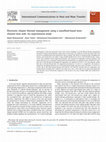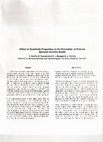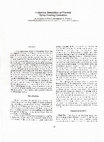Papers by Mohammad Passandideh-Fard
Social Science Research Network, 2022

Experimental Heat Transfer
The continued depreciation of electronic components presents severe challenges for thermal manage... more The continued depreciation of electronic components presents severe challenges for thermal management. Regarding this issue, the current experimental study targets to propose and assess two passive cooling (using a heat sink and rough surface) and two active cooling (air and water cooling) for improving the cooling efficiency of aluminum heat sink heat pipes (HSHPs). In roughening process, the fins are chemically etched using a lab-made simple, cost-efficient, and environmental-friendly method to achieve better cooling performance synergistically. Scanning electron microscopy and atomic force microscopy characterizations are executed to investigate the heat sink surfaces' micro/nano roughened structure. Current results and related comparative studies of the three cooling modules (typical, liquid-based, and liquid-based micro/nano roughened HSHPs) are presented as well, where effects of constant/intermittent heat fluxes (4000-12000 W/m2) and the volume flow rates of testing fluid on heat transfer characteristics, thermal resistance, and temperature behavior are disclosed. Based on findings, at a constant heat flux, roughening the HSHP fins led to an enhancement in cooling through fins and a reduction in cooling through the water. Moreover, it is found that the modified HSHP without testing fluid and with water at volume flow rates of 100 and 200 ml/min decreases the thermal resistance by 11.9, 13.7, and 3.6%, in order, compared with the typical HSHP.
Journal of Energy Storage
SSRN Electronic Journal, 2022

In this study, a PVT system equipped with a nanofluid-based collector is investigated from heat t... more In this study, a PVT system equipped with a nanofluid-based collector is investigated from heat transfer and first law of thermodynamic. For this purpose, the effects of adding nanoparticles on heat transfer are investigated using a 2D-transient numerical model validated with experimental measurements. The experiments were performed for various nanofluids (Al2O3/water, TiO2/water and ZnO/water by 0.2wt%, and SiO2/water by 1wt% and 3wt%) on a PV system equipped with a serpentine collector tube to increase its efficiency. The thermophysical properties for the fluid are assumed to be temperature dependent. A good agreement is observed between model calculations and those of the measurements. For this comparison, mass flow rate, solar radiation, and inlet and ambient temperatures were kept constant. The effects of various nanofluids on thermo-physical properties and coolant fluid heat transfer are examined. It is observed that by increasing the mass fraction of nanofluid in the range co...

Applied Thermal Engineering, 2021
Abstract The purpose of this experimental research is to improve the electrical and thermal outpu... more Abstract The purpose of this experimental research is to improve the electrical and thermal output power of a photovoltaic thermal (PVT) module equipped with an automatic dual-axis solar tracker system. The focus of this study is on characterizing the performance of a PV unit and a PVT module both with three different modes of fixed, one-axis tracking, and dual-axis tracking. These modules were installed at the rooftop of the engineering faculty building of Ferdowsi University of Mashhad, Iran. The test fluids are deionized water and silicon carbide nanofluid (SiC/water) with 0.5% and 1% mass fractions. The experiments are executed on non-cloudy days with stable weather conditions during September. The thermodynamic analysis is carried out in terms of energy, exergy, and entropy generation to identify and compare the performance of various modules considered in the experiments. It is found that the proposed nanofluid-based PVT module integrated with the solar tracker system has no significant inverse effect on electrical efficiency thanks to using intermittent on/off switching electro-motors. The results showed that considering the power consumption of the pump and tracking electro-motors when nanofluid-based PVT module (SiC/water 1%) with dual-axis, one-axis, and fixed modes are utilized, the increases in the obtained overall energy (exergy) rates compared to that of the fixed PV unit are 268.24 (20.8 W), 245.91 (16.51 W), and 210.32 (9.64 W), respectively.

International Communications in Heat and Mass Transfer, 2020
Development in electronic equipment comes with a serious challenge to provide efficient thermal m... more Development in electronic equipment comes with a serious challenge to provide efficient thermal management methods for lifetime and performance improvement. In this study, the cooling of an electronic chipset (EC) with the aid of a nanofluid-based mini-channel heat sink was studied. The effects of varying heat flux, nanofluid mass fraction, and coolant flow rate within a range of (6000:10000 W/m 2), (0:1%), and (100:300 ml/min), respectively, were examined. Several important parameters, like transient EC temperature, thermal resistance, and energy efficiency were investigated. Experimental data disclosed that at an applied heat flux of 6000 W/m 2 and a flow rate of 100 ml/min, the maximum EC temperature was obtained to be 48.6°C. By increasing the coolant flow rate to 150 and 200 ml/min, this temperature decreased by 1.3 and 2.3°C, respectively. The results indicated that the thermal efficiency (η th) of the liquid-based module using pure water, SiC/water 0.5 and 1% wt. at flow rate of 100 (200 ml/min) became 33.8 (50.7%), 37.9 (55.5%), and 40.4 (58.1%), respectively. The average thermal resistance (R th) reduction was found to be 14.81, 19.64, and 21.21% using water-based heat sink with flow rate of 200 ml/min compared to 100 ml/min in the cases of 6000, 8000, and 10,000 W/m 2 , respectively.

Energy, 2018
In the present study, an experimental setup for a PVT system is designed and fabricated to invest... more In the present study, an experimental setup for a PVT system is designed and fabricated to investigate the economic and environmental aspects of using different nano-oxides/water fluids. Selected coolant fluids are: pure water, ZnO/water, Al 2 O 3 /water and TiO 2 /water nanofluids. To make nanofluids, nanoparticles are dispersed in distilled water by 0.2% weight fractions (wt%), separately. Based on the experimental results the amount of annual emission reduction and cost saving are investigated for different coolants. Furthermore, the payback period of the PVTs is compared with that of a conventional PV unit. The results are presented in five different scenarios due to increasing of the electricity price, up to the final price and the government subsidies for the renewable energy sources (1 st : 10% annual price increasing, with no subsidy, 2 nd : linear increasing price, with no subsidy, 3 rd : 10% the annual price increasing, 50% subsidy, 4 th : linear price increasing, 50% subsidy and 5 th : linear price increasing, 75% subsidy).
Energy Conversion and Management, 2018
Corrigendum to "Optimization and parametric analysis of a nanofluid based photovoltaic thermal sy... more Corrigendum to "Optimization and parametric analysis of a nanofluid based photovoltaic thermal system: 3D numerical model with experimental validation" [Energy Convers. Manage. 160 (2018) 93-108]
Energy Conversion and Management, 2018
This conference was a local conference in Iran which does not publish its proceedings in any spec... more This conference was a local conference in Iran which does not publish its proceedings in any specific journal. The titles of the two papers presented in the conference are: Numerical and Experimental Investigations on the Effect of Adding Nanoparticles on Entropy Generation in PVT Systems. Effects of Nanofluids Thermo-Physical Properties on the Heat Transfer and 1st law of Thermodynamic in a Serpentine PVT System.

Energy Conversion and Management, 2019
This paper presents experimental investigation for the effects of a phase change material (PCM) a... more This paper presents experimental investigation for the effects of a phase change material (PCM) and a nano/ phase change material (nano-PCM) on the thermal performance of an electronic chipset. A thermal storage system using Paraffin wax as a PCM is integrated with a heat sink. Additionally, the PCM is modified as nano-PCM by mixing it with multiwall carbon nanotubes (MWCNTs). The effects of various quantities of the PCM, concentrations of the MWCNTs in the PCM, and different power levels on three different modules of heat sinks (without PCM, filled with PCM, and filled with nano-PCM) are studied in passive and active operating modes. Experiments are also performed when the heat flux is applied intermittently, which commonly encountered in the thermal management of portable electronic devices. The phase front propagation is captured and analyzed by an image processing technique. It is found that the PCM can significantly increase the usage time of the system and the nano-PCM as compared to the PCM can extend this time under passive cooling condition. Under active cooling condition, the usage of PCM and nano-PCM may increase the steady-state temperature; however, it reduces the operating temperature of the chipset at the beginning period of the operating time. The nano-PCM module can enhance thermal management of the system by reducing the cooling time up to 6% as compared to the PCM. Under intermittent heating, using more on-and-off cycles lead to decreasing the chipset peak temperature. Using PCM and nano-PCM increases the operating time and reduces the peak temperature of the chipset under intermittent use.
Energy Conversion and Management, 2018

Solar Energy, 2018
In this paper, an experimental study of glass cover and working fluid effects on photovoltaic the... more In this paper, an experimental study of glass cover and working fluid effects on photovoltaic thermal (PVT) system performance is presented. Two similar photovoltaic thermal systems, one with glass cover and one without, are designed and fabricated to perform the experiments. The considered working fluids consist of water, ethylene glycol (EG)/water mixture (50 wt%) and pure ethylene glycol. Outdoor experiments are achieved on selected days in August at the Ferdowsi University of Mashhad, Mashhad, Iran. Energy and exergy analyses are carried out to evaluate electrical and thermal efficiencies of the PVT system. Furthermore, the results for a mixture of EG/water are compared to those using pure deionized water. It is observed that using EG/water mixture (50 wt%) as working fluid not only has a lower freezing point compared to pure ethylene glycol but also has higher overall energy and exergy efficiency compared to those of pure ethylene glycol. Therefore, the EG/ water mixture (50 wt%) is recommended as a suitable working fluid for cold climate conditions. The extensive results also show that since the electrical efficiency of the unglazed PVT system is higher than that of the glazed PVT, when electrical energy is the main interest, the unglazed PVT is preferred. However, if a higher overall energy efficiency is required, the glazed PVT system is recommended.

Energy Conversion and Management, 2018
In this study, the effects of ZnO/water nanofluid and pure water as working fluids on the electri... more In this study, the effects of ZnO/water nanofluid and pure water as working fluids on the electrical and thermal energy efficiencies of a photovoltaic thermal system (PVT) are numerically investigated. The governing equations are discretized and solved using the pressure-based finite volume method by the ANSYS Fluent 16.2 software. The 3D numerical model is validated by comparing the simulation results with those of the measurements. The experiments are performed on selected days in August and September at the Ferdowsi University of Mashhad, Mashhad, Iran. To investigate the reliability of the measurements, an uncertainty analysis is performed for the experiments. The effects of the important operating parameters on the electrical and thermal energy efficiencies of the PVT system with ZnO/water nanofluid are studied. Moreover, the Taguchi method is applied to determine the optimum performance of the nanofluid based PVT system. The considered parameters include: absorbed solar irradiation, wind speed, ambient temperature, coolant inlet temperature, coolant mass flow rate, and nanoparticles mass fraction in the ZnO/water nanofluid. Based on the results of this study, reducing the coolant inlet temperature from 40°C to 20°C enhances the thermal energy efficiency of the nanofluid based PVT system by 16.21%. Moreover, it is found that the considered parameters in this study have slight effects on the electrical energy efficiency of the PVT system. The Taguchi analysis shows that the coolant inlet temperature is the most effective parameter on the efficiency of the nanofluid based PVT system.
Applied Thermal Engineering, 2017
In this study, different neural networks are used for modeling PVT/N systems. Experiments are per... more In this study, different neural networks are used for modeling PVT/N systems. Experiments are performed on ZnO/water nanofluid (0.2 wt%). Particle Swarm Optimization (PSO) is used to find optimum structure of each model. Results of three models are compared and validated with the experiments. Neural networks can be well used in modeling nanofluid based solar systems.
Energy Conversion and Management, 2016
Applied Thermal Engineering, 2020
Experimental investigation and cost analysis on a nanofluid-based desalination system integrated ... more Experimental investigation and cost analysis on a nanofluid-based desalination system integrated with an automatic dual-axis sun tracker and Fresnel lens, Applied Thermal Engineering (2020), doi:

International Thermal Spray Conference
The effect of substrate characteristics on the formation of plasma-sprayed alumina splats was stu... more The effect of substrate characteristics on the formation of plasma-sprayed alumina splats was studied using both experiments and numerical simulation. Knowledge of the particle and substrate conditions is critical in understanding coating formation and in validating computational models. The size, velocity and temperature of the alumina particles prior to impact were measured using a particle in-flight diagnostic system. Experiments were performed on two substrate materials: stainless steel and glass. Substrate temperatures were varied in a range of 20-500°C and controlled with an electric heater. For each substrate material, a transition temperature was observed above which there was no fingering/splashing and the splats had a circular disk shape. A 3D computational model of free surface flows with heat transfer and solidification was used to simulate the impact of alumina particles in conditions given by the experiments. The splat shapes from numerical model were comparable to tho...

A three-dimensional model of free-surface flows with heat transfer, including solidification, was... more A three-dimensional model of free-surface flows with heat transfer, including solidification, was used to model the build-up of a coating layer in a thermal spray process. The impact of several nickel particles on a stainless steel plate in different scenarios was considered. Particles diameter ranged fr om 40 to 80 ~m and their impact velocity ranged from 40 to 80 m/s. Particles were initially super-heated; their temperature ranged from 1600 to 2000°C. Fast growth of solidification was fo und to be .one cause of particle splashing in thermal spray coatIngs. Different splat morphologies obtained from the numerical model were comparable with those obtained from the experiments. Simulation of the sequential impact of two nickel particles showed side-flow jetting and particle splashincr observed in experiments. The numerical model proved to b; capable of simulating different impact scenarios that occur in a thermal .spray; this was demonstrated by simulating nine consecutl ve particles during their impact on the substrate. Scveral characteristics of a coating layer build-up such as particle splashing and formation of small satellite droplets and nngs around the splat could be seen in the numerical results. Particle splashing is one possible cause of porosity formation In thermal spray coatings.









Uploads
Papers by Mohammad Passandideh-Fard